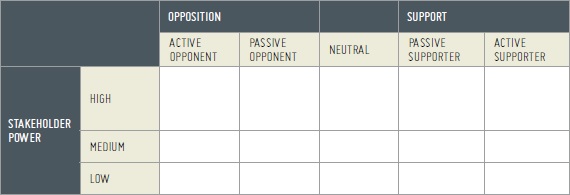Stakeholders’ Mapping
Mapping of stakeholders for CD processes is a useful tool to help understand thesupport or opposition you may get from different actors for a planned change.However, before showing this kind of sensitive information in formal documents orreports, an agreement should be reached about how to collect and present it.
When to use it
It should be conducted and used during the planning stage of a project or programme.
What it is
It is a map that plots stakeholders by their power and by their active or passive support or neutrality.
How to use it
To build the map, you need to analyse your stakeholders according to the following categories:
Stakeholder power
Stakeholders all have power, whether it is the formal power invested in a position of authorityor the social power of being able to persuade others to support or oppose the CD process.
Those with higher power are likely to be your most useful supporters or most dangerous opponents; thus, a power analysis helps you prioritize your focus on stakeholders.
Active and passive support and resistance
Some people will actively support the change, working long hours to help it succeed. Others will work the other way, actively seeking to undermine your efforts.
Neutral actors in the middle
In the middle are the neutral actors who neither support nor oppose the change. They are often playing a waiting game, looking out for who is going to win the game. Once they have made this decision, then they will act.
Other neutral actors are simply undecided. Some people decide quickly while others need more reflection or persuasion. Work hard to persuade them and you may well gain support and build ownership.
Once you have done this analysis, you can write the stakeholders’ names in the appropriate boxes. One technique for doing this in a team is to write the names of the stakeholders on Post-It Notes and stick them up on a big chart on the wall.

Adapted from http://changingminds.org/disciplines/change_management/stakeholder_change

